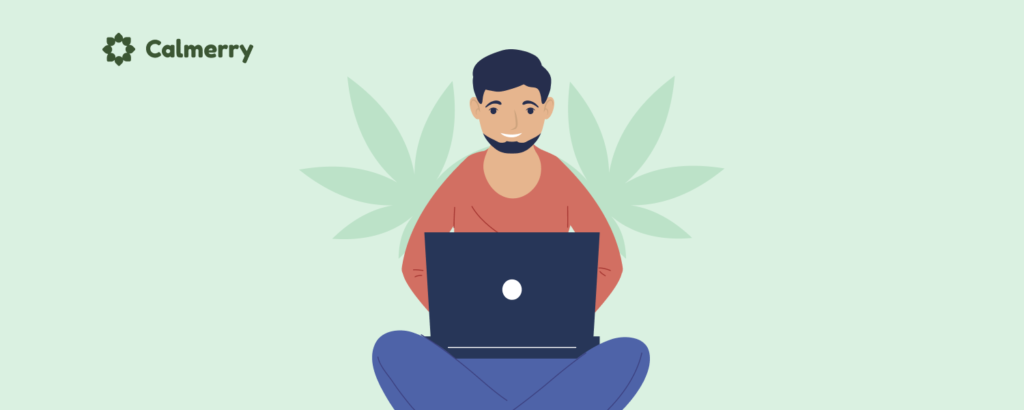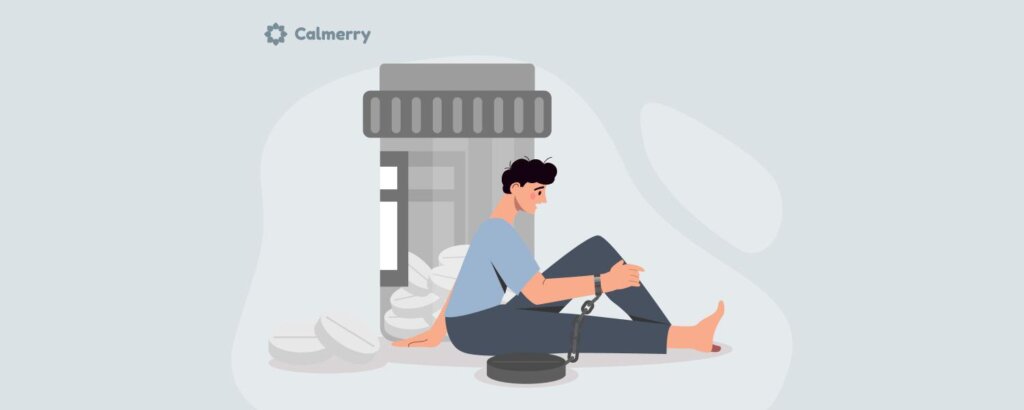Cannabis Use Disorder: What It Is and How to Get Help

In this article
You light up to relax after work. Perhaps to sleep better or manage stress more effectively. It started as an occasional thing, but now you’re reaching for it more often than you planned. You get anxious at times, and quitting doesn’t come easily.
If this sounds familiar, you might be dealing with cannabis use disorder. Despite what you might have heard about weed being harmless or non-addictive, research shows that about 1 in 10 people who use cannabis will develop cannabis dependence [1] National Institute on Drug Abuse. (2024). Cannabis (Marijuana) DrugFacts. Retrieved from https://nida.nih.gov/publications/drugfacts/cannabis-marijuana .
This article breaks down what cannabis use disorder actually is, how to recognize the signs of marijuana addiction, and what marijuana addiction treatment options exist if you’re struggling to cut back or quit.
What is marijuana?
Marijuana comes from the cannabis plant, specifically Cannabis sativa or Cannabis indica. People use the dried flowers, leaves, stems, and seeds to get high. The main psychoactive compound in cannabis products is THC (delta-9-tetrahydrocannabinol), which affects your brain’s reward system. CBD (cannabidiol) is another compound in the cannabis plant, but it doesn’t produce the high that THC does.
People use marijuana in different ways:
- Smoking
- Vaping
- Eating edibles
- Using oils or tinctures
Each method affects how long the effects last and how quickly you feel them.
The effects of marijuana abuse
Short-term effects of marijuana include:
- Altered perception
- Mood changes
- Impaired memory
- Difficulty thinking, problem-solving
- Altered sense of time
Some people feel relaxed and happy. Others get anxious or paranoid.
Long-term marijuana abuse can change how your brain works. Regular, heavy use can affect memory, learning, and attention. It can worsen anxiety and depression in some people.
Contrary to popular belief, you can develop marijuana use disorder with repeated use. The effects of marijuana abuse extend beyond getting high. You may notice a drop in motivation, and your school or work performance may start to slip. Relationships can also get strained when weed becomes a priority.
Is marijuana addictive?
Short answer: Yes, you can get addicted to marijuana.
About 9% of people who use marijuana will develop cannabis use disorder. That number jumps to 17% for those who start using it in their teens [2] Substance Abuse and Mental Health Services Administration. (2023). Key Substance Use and Mental Health Indicators in the United States. Retrieved from https://www.samhsa.gov/data/report/2023-nsduh-annual-national-report . The addiction potential is real, even if it’s lower than substances like alcohol or opioids.
Here’s what happens: Your brain’s reward system gets flooded with dopamine from THC. Your brain starts linking marijuana with pleasure and relief. Over time, you need more to get the same effect. Your brain’s natural dopamine production adjusts to compensate for the change. When you try to stop, withdrawal symptoms kick in.
The idea that “weed isn’t addictive” has stuck around for decades. It’s not true. Weed addiction symptoms develop gradually. For many people, it happens without them realizing it.
What is cannabis use disorder (CUD)?
CUD is a mental health disorder characterized by problematic marijuana use that causes significant impairment or distress. It’s not just about using marijuana frequently. It’s about continuing to use despite negative consequences in your life.
The DSM-5 (Diagnostic and Statistical Manual of Mental Disorders) defines CUD based on 11 criteria [4] American Psychiatric Association. (2024). The diagnosis and treatment of anxiety disorders. In The American Psychiatric Association Publishing Textbook of Anxiety, Obsessive-Compulsive and Posttraumatic Stress Disorders (pp. 145-168). Retrieved from https://doi.org/10.1176/appi.books.9780890425596 . Meeting 2-3 criteria indicates mild CUD, 4-5 indicates moderate, and 6 or more indicates severe cannabis use disorder.
What’s the difference between marijuana use disorder and marijuana addiction?
These terms are often used interchangeably. However, there’s a subtle distinction. Marijuana use disorder is the clinical diagnosis that covers a spectrum from mild to severe. Marijuana addiction typically refers to the severe end of that spectrum, where physical dependence and compulsive use dominate.
In practical terms, both describe the same problem: You’ve lost control over your marijuana use, and it’s causing problems in your life. The severity just varies.
How common is CUD?
More common than most people think. Among adults who use marijuana, about 10-30% will develop some level of cannabis dependence [1] National Institute on Drug Abuse. (2024). Cannabis (Marijuana) DrugFacts. Retrieved from https://nida.nih.gov/publications/drugfacts/cannabis-marijuana . The rates are higher among daily or near-daily users. Roughly 25-50% of people who use marijuana this frequently meet the criteria for marijuana use disorder.
As marijuana legalization spreads and potency increases (today’s cannabis products often contain 15-25% THC compared to 3-4% in the 1990s), rates of marijuana use disorder are climbing.
Addiction to marijuana: symptoms
Recognizing the symptoms of cannabis use disorder early makes treatment more effective. Here are the signs of marijuana addiction:
Cannabis addiction signs related to use patterns:
- Using more marijuana or using it longer than you intended
- Spending significant time using or recovering from marijuana
- Craving or strong urges to use marijuana
- Wanting to cut down or stop, but being unable to
- Building tolerance (needing more to get the same effect)
Impact of marijuana on daily life: signs
- Continuing to use despite recurring problems at work, school, or home
- Giving up important activities because of marijuana use
- Using in situations where it’s physically dangerous (like driving)
- Continuing use despite knowing it’s causing or worsening physical or psychological problems
- Using marijuana despite social or relationship problems caused by it
Marijuana addiction symptoms are related to withdrawal
The withdrawal symptoms might surprise you. Many people don’t realize marijuana withdrawal is a real thing. But if you’ve been using heavily and regularly, stopping can bring uncomfortable symptoms that typically peak within the first week and can last 1-2 weeks.
THC brain effects include:
- Irritability
- Sleep problems
- Decreased appetite
- Restlessness
- Mood changes
- Physical discomfort
What causes cannabis use disorder?
No single factor causes marijuana addiction. It’s usually the result of several factors working together.
Why is marijuana addictive?
THC activates cannabinoid receptors in your brain’s reward system. This triggers dopamine release, creating that pleasurable high. With repeated use, your brain adapts. It produces less dopamine naturally and reduces the number of cannabinoid receptors. You need marijuana just to feel normal. That’s how THC affects your brain to create dependence.

Weed dependence development factors:
- Genetics. If addiction runs in your family, you’re more vulnerable.
- Early use. Starting in adolescence, when the brain’s still developing, the risk increases significantly.
- Mental health conditions like anxiety, depression, or ADHD.
- Environmental factors: peer pressure, stress, trauma, and easy access to marijuana.
The progression from casual use to marijuana use disorder doesn’t happen overnight. It develops gradually as your brain chemistry changes and marijuana becomes your default coping mechanism for stress, boredom, or difficult emotions.
What are the risk factors for cannabis use disorder?
Certain factors increase your likelihood of developing marijuana use disorder.
Marijuana addiction risk factors:
- Starting marijuana use during adolescence or young adulthood
- Family history of substance use disorders
- Having other mental health disorders (anxiety, depression, PTSD, ADHD)
- History of trauma or adverse childhood experiences
- Peer groups that heavily use marijuana
- Easy access to high-potency cannabis products
- Using marijuana to cope with stress, anxiety, or other difficulties
- Being male (though women may progress from initial use to dependence faster)
These risk factors can add up. The more risk factors you have, the higher your chances of developing problematic use. But risk factors aren’t destiny. Plenty of people with multiple risk factors use marijuana occasionally without developing weed dependence.
Marijuana effects on daily life
Weed dependence goes way beyond just changing your brain chemistry. It can gradually affect nearly every area of your life.
Your memory starts getting unreliable. Conversations slip away, appointments get missed, and you lose your place with tasks you meant to finish. The marijuana cognitive effects make it harder to learn new things and slow down how you solve problems. At work or school, your performance starts sliding. You’re not as motivated, your focus isn’t there, and people can’t count on you the way they used to.
Weed addiction and memory problems extend to relationships:
Friends notice you’re less present. Family members feel like marijuana matters more than they do. Conflicts increase as people close to you express concern about your use. You might start avoiding people who question your marijuana use or only spend time with others who use.
Weed impact on work/school manifests as:
- Missing deadlines or showing up late
- Decreased productivity and quality of work
- Using before or during work/school
- Prioritizing marijuana over responsibilities
- Financial problems from spending money on weed
Your physical health takes hits, too. Chronic bronchitis from smoking. Increased heart rate. For some, severe nausea and vomiting (cannabis hyperemesis syndrome). Sleep quality often worsens despite using marijuana to fall asleep.
What are the complications of cannabis use disorder?
Long-term marijuana use and CUD can lead to serious health problems.
Marijuana health risks include:
- Cannabis-induced psychosis: High-potency THC products can trigger psychotic episodes, especially in people predisposed to psychotic disorders. Symptoms include:
- Hallucinations
- Delusions
- Disorganized thinking
For some people, this can be the first sign of an underlying mental health disorder like schizophrenia.
2. Cannabis hyperemesis syndrome: A condition causing severe, recurring nausea and vomiting in chronic marijuana users. The only relief? Hot showers or baths. The only cure? Stopping marijuana use completely.
3. Respiratory problems: Smoking marijuana irritates your lungs. Chronic bronchitis, coughing, and increased phlegm production are common. The long-term effects of marijuana smoke on lung health are still being studied, but they’re concerning.
4. CUD health effects on the cardiovascular system: Marijuana increases heart rate and blood pressure immediately after use. For people with heart conditions, this poses serious risks.
5. Mental health complications: Marijuana use disorder often co-occurs with anxiety disorders, depression, and other mental health problems. The relationship is complex. Sometimes marijuana use triggers these conditions, sometimes people use marijuana to cope with existing mental health issues, and often both factors interact.
6. Cognitive decline: Heavy long-term use, especially starting in adolescence, is associated with lasting impacts on memory, attention, and executive function.
How is cannabis use disorder diagnosed?
Healthcare providers diagnose cannabis use disorder based on the DSM-5 criteria [4] American Psychiatric Association. (2024). The diagnosis and treatment of anxiety disorders. In The American Psychiatric Association Publishing Textbook of Anxiety, Obsessive-Compulsive and Posttraumatic Stress Disorders (pp. 145-168). Retrieved from https://doi.org/10.1176/appi.books.9780890425596 . A mental health professional will assess:
- Your patterns of marijuana use
- Negative consequences you’ve experienced
- Failed attempts to cut back
- Withdrawal symptoms
- How marijuana affects your daily functioning
- Whether you meet two or more of the 11 diagnostic criteria
Diagnosis severity depends on how many criteria you meet. The assessment also looks at co-occurring mental health disorders and other substance use. Honest reporting helps—your provider isn’t there to judge you, but to understand what you’re dealing with so they can recommend appropriate treatment options for CUD.
How is cannabis use disorder treated?
Good news: treatment for marijuana use disorder actually works. When people get help, most of them manage to cut back significantly or stop using marijuana altogether.
Cannabis treatment approaches include:
Cognitive behavioral therapy for cannabis use disorder
CBT has been studied more than any other treatment for marijuana addiction, and there’s a reason why: it genuinely helps. You’ll work on recognizing what triggers your marijuana use, figure out ways to handle cravings when they hit, examine the thoughts that pull you toward using, and practice saying no to marijuana in social settings. Research shows CBT significantly reduces marijuana use and helps people maintain abstinence [3] Connor, J. P., Manthey, J., Hall, W., Stjepanović, D., et al. (2024). Effectiveness of cannabis use and cannabis use disorder interventions: a European and international data synthesis. European Archives of Psychiatry and Clinical Neuroscience. Advance online publication. Retrieved from https://www.ncbi.nlm.nih.gov/pmc/articles/PMC11910397/ .
Motivational enhancement therapy
This one focuses on building up your own reasons for changing. It’s particularly effective if you’re ambivalent about quitting or reducing use. Maybe you’re not sure you want to stop completely, or you’re still on the fence about whether it’s really a problem.
Contingency management
This involves providing tangible rewards for abstinence, verified through drug testing. It’s highly effective for promoting marijuana abstinence during treatment.
Support groups
Groups like Marijuana Anonymous provide peer support and a structured approach to recovery. The community aspect helps many people stay committed to change.
Online therapy for marijuana addiction
Digital cannabis therapy makes treatment more accessible. You can work with a therapist specializing in substance use disorders from home. This eliminates barriers such as transportation, scheduling conflicts, or stigma associated with walking into a treatment facility.
Medication
Currently, no FDA-approved medications specifically treat marijuana use disorder, though research is ongoing. Providers may prescribe medications to manage withdrawal symptoms or treat co-occurring mental health disorders.

Detoxification
While marijuana withdrawal is usually not medically dangerous, it can still feel very uncomfortable.
Marijuana withdrawal symptoms and management include:
- Physical symptoms (headaches, sweating, chills, and stomach problems that peak in the first few days)
- Sleep problems that can persist for weeks (trouble falling asleep, vivid dreams, night sweats)
- Psychological withdrawal symptoms (irritability, anxiety, depression, restlessness, and strong cravings)
Most people can manage marijuana withdrawal at home with support. Stay hydrated, eat regular meals even if your appetite has gone, exercise to help with your mood and sleep, and use relaxation techniques to manage anxiety. Professional support makes the process easier and increases success rates.
How to prevent cannabis use disorder?
If you’re currently using marijuana occasionally and want to avoid developing a problem:
- Set clear limits on frequency and amount before you use
- Avoid using marijuana to cope with difficult emotions or stress
- Don’t use daily or near-daily
- Take regular breaks from use to ensure you can stop without discomfort
- Be honest with yourself about why you’re using
- Avoid high-potency products
- Don’t use it if you have risk factors like a family history of addiction or mental health disorders
- Find healthy coping strategies for stress, anxiety, or boredom
For young people, delaying marijuana use until adulthood significantly reduces risk. The developing brain is more vulnerable to the risk of cannabis dependence.
What can I expect if I have cannabis use disorder?
Here’s the thing: marijuana use disorder is treatable. With appropriate cannabis treatment, most people either manage to quit completely or cut back enough that it stops being a problem.
But recovery doesn’t follow a straight line. You’ll probably have setbacks along the way, and that’s just how it goes. What really matters is that you keep working toward change. Those first few weeks are usually the toughest part, when you’re dealing with withdrawal symptoms and figuring out new coping strategies. After about 1-3 months, most people start feeling significantly better. Their thinking becomes clearer, their mood improves, relationships begin to heal, and their motivation returns.
Long-term recovery involves building a life where marijuana isn’t the center. This means developing healthy coping mechanisms, rebuilding relationships, pursuing activities that bring genuine satisfaction, and addressing any underlying mental health issues.
When to seek help
CUD can make you feel really alone. You might think you’re the only person who can’t get a handle on something everyone else treats as no big deal. But you’re not. Marijuana addiction affects millions of people, and there’s effective treatment out there that actually works.
The first step? Just admitting there’s a problem. If your marijuana use is interfering with your life (your health is suffering, your relationships are strained, work becomes difficult, or you just don’t feel okay mentally), that’s reason enough to get help. You don’t need to hit rock bottom before making changes.
Recovery is possible. When you find the right support and treatment approach, you can regain control over your marijuana use and build a life that doesn’t revolve around getting high.
Where and how to get help
If you’re struggling with weed addiction, professional support makes a real difference. Calmerry specializes in addiction counseling, including cannabis therapy. You’ll work with licensed therapists who understand marijuana addiction and use evidence-based approaches like CBT to help you reduce or stop use.
The process is simple:
- Complete a brief assessment about your marijuana use and treatment goals
- Get matched with a therapist who specializes in substance use disorders
- Choose your preferred format—video, text, or phone sessions
Online therapy removes barriers that keep people from getting help. No commuting. Flexible scheduling around work or family. Lower cost than traditional in-person therapy. And complete privacy—no one needs to know you’re seeking treatment unless you choose to tell them.
FAQ
Can you get addicted to marijuana?
Yes. About 9% of marijuana users develop cannabis use disorder, rising to 17% among those who start in adolescence. Marijuana addiction involves both psychological and physical dependence.
What are the first signs of marijuana addiction?
Using more than intended, unsuccessful attempts to cut back, spending significant time obtaining or using marijuana, cravings, and continuing use despite negative consequences in relationships or responsibilities.
How long does marijuana withdrawal last?
Most withdrawal symptoms peak within the first week and resolve within 1-2 weeks. Sleep problems and mood changes may persist longer, typically improving significantly by 3-4 weeks.
Is CBD addictive like THC?
No. CBD doesn’t produce the euphoric effects of THC and doesn’t carry the same addiction potential. It doesn’t activate the brain’s reward system the way THC does.
Will I need to quit marijuana completely?
That depends on severity. Some people with mild CUD successfully moderate use. For moderate to severe cases, abstinence is typically the most effective approach for long-term recovery.
Does insurance cover cannabis use disorder treatment?
Many insurance plans cover substance use disorder treatment, including therapy for CUD. Coverage varies by plan. Contact the Calmerry team to explore treatment options for cannabis-related mental health problems.
National Institute on Drug Abuse. (2024). Cannabis (Marijuana) DrugFacts. Retrieved from https://nida.nih.gov/publications/drugfacts/cannabis-marijuana
Substance Abuse and Mental Health Services Administration. (2023). Key Substance Use and Mental Health Indicators in the United States. Retrieved from https://www.samhsa.gov/data/report/2023-nsduh-annual-national-report
Connor, J. P., Manthey, J., Hall, W., Stjepanović, D., et al. (2024). Effectiveness of cannabis use and cannabis use disorder interventions: a European and international data synthesis. European Archives of Psychiatry and Clinical Neuroscience. Advance online publication. Retrieved from https://www.ncbi.nlm.nih.gov/pmc/articles/PMC11910397/
American Psychiatric Association. (2024). The diagnosis and treatment of anxiety disorders. In The American Psychiatric Association Publishing Textbook of Anxiety, Obsessive-Compulsive and Posttraumatic Stress Disorders (pp. 145-168). Retrieved from https://doi.org/10.1176/appi.books.9780890425596
online therapy
live video session



